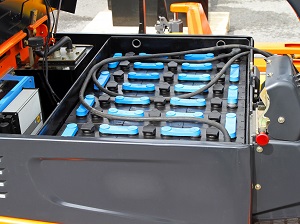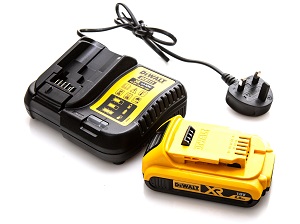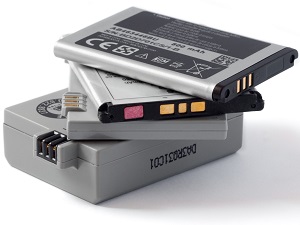There are quite a few safety precautions and OSHA standards that pertain to battery charging, handling, and storage. When handled and stored properly in the workplace or at the job site, batteries can be safe.

There are many types of batteries including alkaline, lead-acid, and lithium and most batteries are typically classified as either primary (non-rechargeable) or secondary (rechargeable).
All workers should be aware of the types of batteries in use or being stored at the job site, how to handle them properly (if that is part of their job), how to recognize the dangers, and what to do with a defective battery.
Hazards associated with batteries and battery chargers while in use, handling, in storage, or the battery is charging include:
- overheating
- fire or explosion
- electrical shock from battery chargers
- thermal burns
- exposure to corrosive battery electrolytes
- overexertion injuries from handling heavy batteries
Not all types of batteries will be used at every job site so it’s important to do a hazard assessment on battery usage that is specific to every work environment and adapt the safety program and precautions accordingly.

Only charge batteries in the designated charging area. This will make it easier to control ventilation and ensure there is safety equipment within reach.
OSHA Construction Standard 1926.441(b)(1) and General Industry Standard 1910.178(g)(1) Battery charging installations shall be located in areas designated for that purpose.
Safety equipment should be readily available in battery charging, handling, and storage areas and may include a fire extinguisher, eyewash station, and neutralization materials.
OSHA General Industry Standard 1910.178(g)(2) Facilities shall be provided for flushing and neutralizing spilled electrolyte, for fire protection, for protecting charging apparatus from damage by trucks, and for adequate ventilation for dispersal of fumes from gassing batteries.
Precautions must be taken to prevent all ignition sources in battery areas including open flames, sparks, or electric arcs. Smoking must be prohibited in the charging area.
Battery chargers must be protected from collisions, including impacts from forklifts.
OSHA Construction Standard 1926.441(b)(2) Charging apparatus shall be protected from damage by trucks.
Check battery vent caps to ensure they are functioning. Keep tools and other metallic objects, including jewelry, away from the top of uncovered batteries.

The forklift battery change out process can be dangerous if safety procedures aren’t followed. Batteries can be heavy and cause injuries if they are not handled properly. A conveyor, hoist, or other material handling equipment may need to be used when moving batteries.
Ensure the forklift is properly positioned, with the brake applied, before attempting to change or charge batteries. Secure batteries as originally intended by the manufacturer. Don’t forget to replace the restraining device on the battery compartment after changing out a battery. To prevent spills a tilter or a siphon should be used when handling electrolyte.
There must be adequate ventilation provided to the battery storage areas.
OSHA General Industry Standard 1910.305(j)(7) Provisions shall be made for sufficient diffusion and ventilation of gases from storage batteries to prevent the accumulation of explosive mixtures. OSHA Construction Standard 1926.441(a)(2) Ventilation shall be provided to ensure diffusion of the gases from the battery and to prevent the accumulation of an explosive mixture.
Workers handling batteries or acids must be provided with and use proper personal protective equipment (PPE), which may include acid-resistant face shields, aprons, and rubber gloves.

While battery-powered tools are designed to increase productivity on the job site, even cordless power tools can be dangerous if all safety precautions are not followed carefully. Workers should follow all warning and instructions for each specific power tool, compatible batteries, and related accessories.
Before inserting a battery pack, be sure the power switch is turned off. Batteries for cordless power tools might not be interchangeable. Only choose batteries and chargers from the original power tool manufacturer.
Always transport and store batteries as instructed in the operator’s manual. Do not store batteries in a way that will allow them to come in contact with metal like keys, coins, screws, nails, or other small metal objects, as this can potentially short the battery causing sparks, fires or burns.
Remove the battery before changing accessories or performing any adjustments on the power tool. Remove the battery when the cordless power tool is not in use.
Inspect batteries before use for signs of damage. Do not use a battery that has been damaged. Never modify, disassemble, or tamper with a battery, as the result can be unpredictable and dangerous. Do not dispose of batteries by tossing them in the garbage. Recycling is a better option.

Lithium batteries are generally safe and unlikely to fail, but only so long as there are no defects, and the batteries are not damaged. When lithium batteries fail to operate safely or are damaged, they may present a fire and/or explosion hazard.
Damage to lithium batteries can occur immediately or over a period of time, from physical impact, exposure to certain temperatures, and/or improper charging. Remove lithium-powered devices and batteries from the charger once they are fully charged.
Workplace injuries from lithium battery defects or damage are preventable. Follow manufacturer’s instructions for storage, use, charging, and maintenance. Store lithium batteries and devices in dry, cool locations.
When replacing batteries and chargers for an electronic device, ensure they are specifically designed and approved for use with the device, and they are purchased from the device’s manufacturer, or a manufacturer authorized reseller.
Avoid damaging lithium batteries and devices. Inspect them for signs of damage, such as bulging/cracking, hissing, leaking, rising temperature, and smoking before use, especially if they are wearable. Immediately remove a device or battery from service and place it in an area away from flammable materials if any of these signs are present.
If batteries are damaged, remove them from service, place in fire resistant container, like a metal drum, with sand or other extinguishing agent, and contact a local battery recycling center for disposal instructions.
Follow manufacturer’s guidance on how to extinguish small battery fires, which could include using ABC dry chemical extinguishers, Class D fire extinguishers (for lithium-metal), dirt, or sand.


